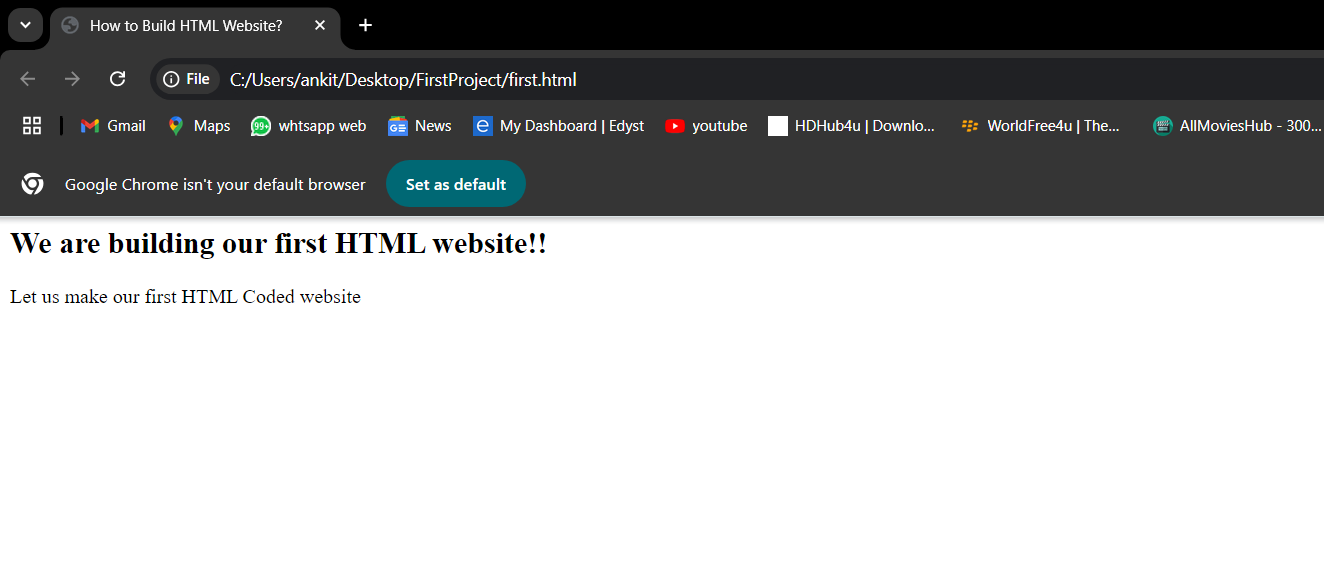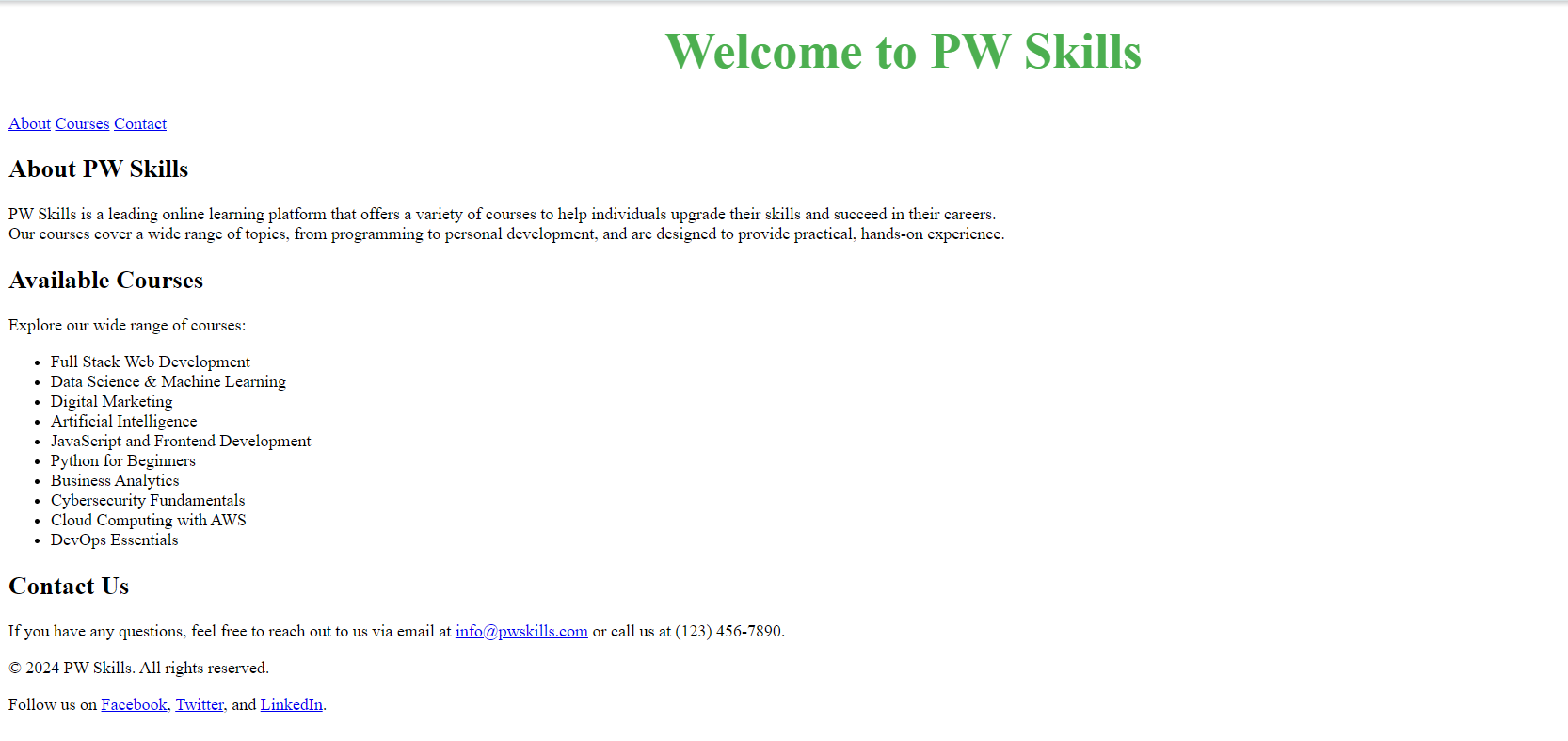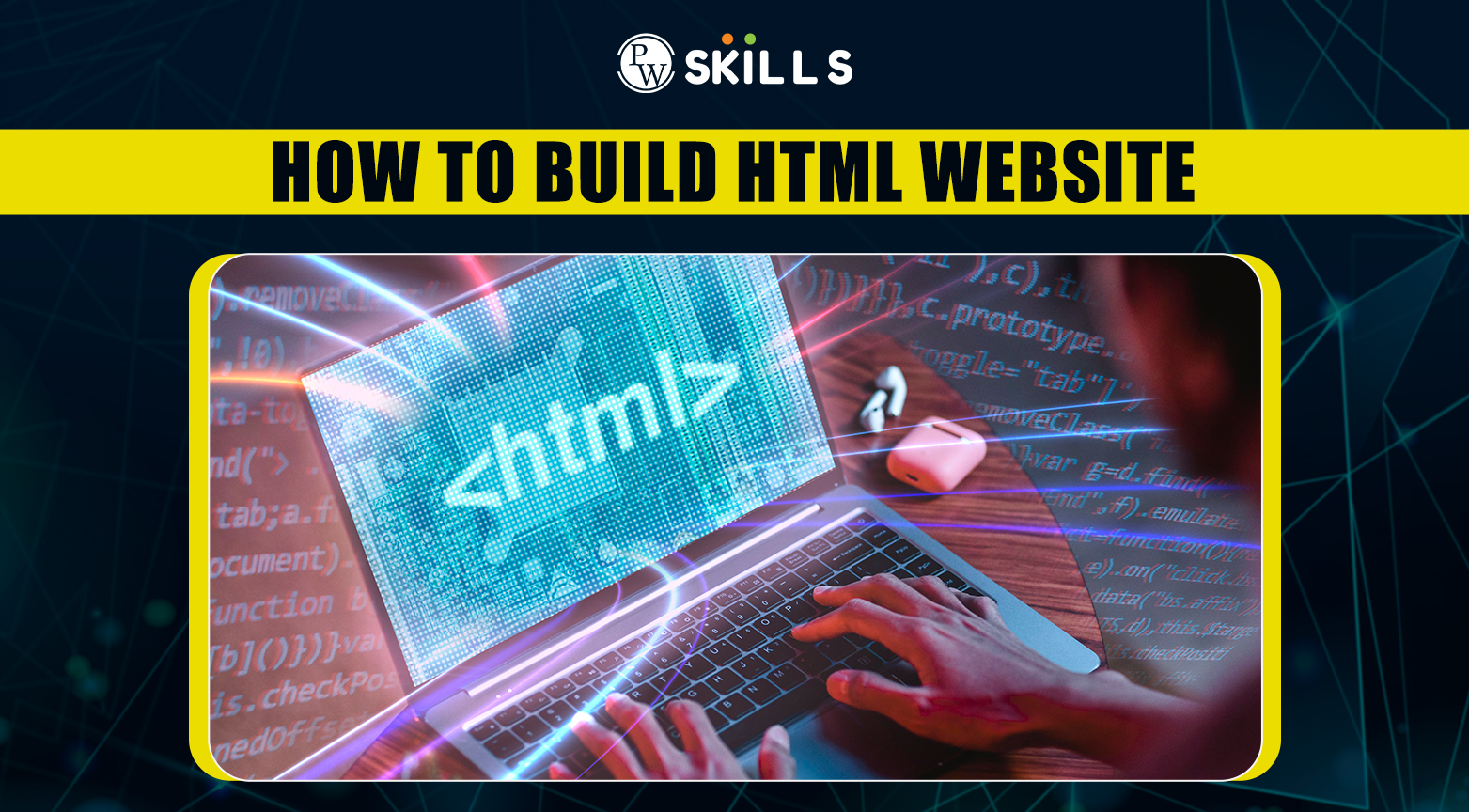If you want to know how to build html website, then HTML is the language to start building your own platform. The Hyper Text Markup Language is a code or language that is used to define the structure and blueprint of a website.
HTML lays the foundation of complete web development as it defines all the elements, headers, links, lists, and paragraphs to be used in our website. Once you learn the fundamentals and basics then you will easily learn to design and optimise your website more effectively using other frameworks like CSS, React, Angular, PHP, etc. In this tutorial, learn how to build html website.
Why Html for Our Website?
HTML is a markup language that helps to define the complete structure of our website or web page. Take our body as an example, just like our bones or skeletal system keeps our body intact or defines our structure. Every organ is kept in its defined place which allows smooth functioning of our body.
Similarly, HTML represents the skeletal part of our body which defines where each element of our web page is kept. It defines the complete structure of our website. Therefore, it is important to know how to build html website.
Setup HTML Document Page
To create a simple HTML website, it is important to set up your HTML document page properly. You can code your HTML page on Notepad, a local code editor (Visual Studio Code, Atom), or an online HTML Code editor.
- Step 1: Open your code editor platform to any code editor of your choice, such as Notepad, Visual Studio Code, etc.
- Step 2: Check the following basic example to help you understand how to build html website. First, we will learn to set up our HTML document, which will be used to render our website on the server.
| <html>
<head> <title> How to build HTML Website?<title> </head> <body> <h2> We are building our first HTML website!! </h2> <p> Let us make our first HTML Coded website </p> </body> </html> |

- Step 3: Save the file with a .html extension

- Step 4: Go to the project folder “FirstProject” and click on the first.html or select open with Chrome to display the code on the local server.
- Step 5: Open the file in the browser. You can use any browser either Chrome, Bing, etc.

How to Build HTML Website From Scratch?
HTML is the first step toward building your custom-made website using a lot of other frameworks and tools. There are many HTML tags that will help you lay the foundation for your customised website.
Html root tag i,e. <html> tells the server that this file loading on the server is an HTML file. The <html> file contains all other elements or the structure of your website. Every other framework, like CSS, bootstrap, React, PHP, etc is integrated with the HTML to complete the interface and functionalities of your website.
After defining the framework for our website, we have several important steps that set up our complete website.
- Define the structure and layout of the website using HTML
- Style the HTML elements using CSS
- Add functionalities, and interaction using Javascript
- PHP, Express, Django, Ruby on Rails, etc
Important HTML Tags For Building Websites
Check some of the most important HTML tags and elements used to define the structure of your website.
Document Structure Tags
These tags are used at the start of the HTML document and are used to wrap the entire document within. It contains the following tags, as mentioned below.
| <!DOCTYPE html> | It is used to declare the type of documents i,e. HTML to the servers |
| <html> | It is the root element tag that wraps the entire HTML element within. |
| <head> | It contains all the important links or information like metadata, stylesheet links, scripts, and other elements. |
| <title> | It defines the title of the browser tab or the page server |
| <body> | All the HTML content is kept within the body tag. All the contents which are to be rendered on the website are listed inside the body tag |
2. Content Tags
It contains all the elements or tags to be rendered on the web page.
| Tag | Description |
| <header> | Defines a header section, often used for navigation links, logos, or intro information. |
| <nav> | Contains navigation links, such as menus. |
| <h1> to <h6> | Defines headings in different levels, with <h1> as the main heading. |
| <p> | Defines a paragraph of text. |
| <a> | Creates a hyperlink. Use href to set the destination. |
| <img> | Embeds an image, with the src attribute pointing to the image source. |
| <section> | Defines a thematic grouping of content. |
| <article> | Wraps self-contained content, like a blog post or article. |
| <footer> | Defines the footer section, often for copyright info or extra links. |
3. Media and Layout Tags
All the multimedia contents are embedded on the web page using the following HTML tags given below.
| Html Tag | Description |
| <div> | A generic container used to group elements, often styled with CSS. |
| <span> | The inline container is used to style specific parts of text. |
| <ul> | Defines an unordered list. |
| <ol> | Defines an ordered list. |
| <li> | List item, used within <ul> or <ol>. |
| <table> | Used to create a table structure for displaying data. |
| <tr> | Table row, used within <table>. |
| <td> | Table cell, used within <tr> for individual data items. |
| <th> | Table header cell, used within <tr> for headings in tables. |
4. Form Tags
These HTML elements are used to define the forms that can be interacted with or completed by the users connecting with the web page
| Tag | Description |
| <form> | Creates a form for collecting user input. |
| <input> | Creates an input field of various types (text, password, submit, etc.). |
| <label> | Labels an input field to improve accessibility and usability. |
| <button> | Creates a clickable button. |
| <textarea> | Creates a multi-line text input area. |
| <select> | Creates a dropdown list; works with <option> tags for each choice. |
5. Semantic Tags
These tags are used to increase accessibility, visibility, and SEO optimization.
| Tag | Description |
| <main> | Identifies the main content of the document, improving accessibility and SEO. |
| <aside> | Sidebar content, often for additional information like widgets or ads. |
| <strong> | Highlights important text, generally rendered as bold. |
| <em> | Emphasizes text, usually rendered as italicized text. |
6. Script and Style Tags
These tags are used to define the styling and script. Check the most important tags below.
| Tag | Description |
| <link> | Links to external resources like stylesheets (rel=”stylesheet”). |
| <style> | Embeds internal CSS directly in the HTML, typically in the <head>. |
| <script> | Embeds or links to JavaScript, adding interactivity to the webpage. |
Example of an HTML Coded Website
Let us view a simple representation of an HTML-coded website built using the HTML language.
| <!DOCTYPE html>
<html lang=”en”> <head> <meta charset=”UTF-8″> <meta name=”viewport” content=”width=device-width, initial-scale=1.0″> <title>PW Skills – Courses</title> </head> <body> <header> <h1 style=”text-align: center; font-size: 3em; color: #4CAF50; font-weight: bold; margin-top: 20px;”> Welcome to PW Skills </h1> <nav> <a href=”#about”>About</a> <a href=”#courses”>Courses</a> <a href=”#contact”>Contact</a> </nav> </header> <main> <section id=”about”> <h2> About PW Skills </h2> <p> PW Skills is a leading online learning platform that offers a variety of courses to help individuals upgrade their skills and succeed in their careers. <br>Our courses cover a wide range of topics, from programming to personal development, and are designed to provide practical, hands-on experience.</p> </section> <section id=”courses”> <h2>Available Courses</h2> <p>Explore our wide range of courses:</p> <ul> <li>Full Stack Web Development</li> <li>Data Science & Machine Learning</li> <li>Digital Marketing</li> <li>Artificial Intelligence</li> <li>JavaScript and Frontend Development</li> <li>Python for Beginners</li> <li>Business Analytics</li> <li>Cybersecurity Fundamentals</li> <li>Cloud Computing with AWS</li> <li>DevOps Essentials</li> </ul> </section> <section id=”contact”> <h2>Contact Us</h2> <p>If you have any questions, feel free to reach out to us via email at <a href=”mailto:info@pwskills.com”>info@pwskills.com</a> or call us at (123) 456-7890.</p> </section> </main> <footer> <p>© 2024 PW Skills. All rights reserved.</p> <p>Follow us on <a href=”https://www.facebook.com/pwskills” target=”_blank”>Facebook</a>, <a href=”https://www.twitter.com/pwskills” target=”_blank”>Twitter</a>, and <a href=”https://www.linkedin.com/company/pwskills” target=”_blank”>LinkedIn</a>. </p> </footer> </body> </html> |

Become a Web Developer with PW Skills
If you want to build a career in web development and find the right guidance, then enrol in the PW Skills Full Stack Web Development Course to get in-depth knowledge of building responsive and interactive website applications.
Learn to handle both the front end and back end of the website with advanced frameworks, tools, and technologies. Build real world projects and work on practice exercises with pwskills.com
How to build HTML Website FAQs
Q1. Can I build a website with HTML?
Ans: You can build a basic website with HTML. There are many HTML website templates that you can use as a reference to structure your website.
Q2. Does HTML build websites?
Ans: HTML is a standard markup language used to create website structure and layout.
Q3. How do I code a website?
Ans: Follow the simple steps to start coding for your own website.
Plan a simple layout
Setup the code editor platform
Plan the elements to be listed in your code
Create the HTML document
Integrate other frameworks like CSS, Bootstrap, Javascript, etc to define the website functionalities
Q4. Is it hard to learn HTML?
Ans: HTML is a standard markup language used to define the basic layout of a web page. You only need simple knowledge of HTML elements, tags, and attributes, which is not very hard considering the entire web development.
Q5. Can I use HTML website code copy paste?
Ans: There are many websites that provide html website templates, home page HTML code with CSS, and sample HTML code for the homepage.

